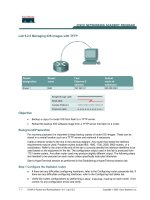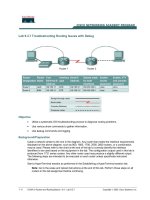Stich seam types with description.PPT
Bạn đang xem bản rút gọn của tài liệu. Xem và tải ngay bản đầy đủ của tài liệu tại đây (11.12 MB, 54 trang )
Stitch Types
Name : MAZADUL HASAN SHESHIR
ID: 2010000400008
Batch: 13th Batch (Session 2009-2013)
Department: Wet Processing Technology
Email: (FB)
Blog: www. Textilelab.blogspot.com
Southeast University,Bangladesh
Department of Textile Engineering
PREPARED BY
©right
Stitch Types
Lockstitch Chainstitch
Oscillating shuttle Rotary hook
* Domestic * Industrial
Rotary looper Oscillating looper
* Button Stitching * 2T- chain
Overlock
Coverseam
Stitch Type 301
N
B
Lockstitch
Lock Stitch
Lockstitch, has a needle thread and a bobbin thread.
Stitch is formed by a needle thread introduced from one
side of the material interlacing with an under thread
The needle & under thread cross over in the middle of the
fabric
Most common of the stitch types
Does not unravel easily,
Poor extention.
Stitch is reversible
Uses least amount of thread
Excellent seam security
Lower productivity
More susceptible to thread breaks
Used in wide range of end uses.
Stitch Type 301
Stitch Type 304
N
B
ZIG ZAG ONE STEP
LOCKSTITCH
Lockstitch zig zag, has a needle thread
and a bobbin thread.
Has same benefits as 301 viz:
security of seam
reversibility
wont unravel easy
Has better extension due to the zig zag
configuration.
Used mostly on lingerie , foundation
wear and underwear, where a secure
seam with good extension is required.
Stitch Type 304
Stitch Type 304
ZIG ZAG ONE STEP
LOCKSTITCH
Stitch Type 401
N
L
Two Thread Chain Stitch
Two Thread Chain Stitch
Two thread chainstitch - one needle thread
and one looper thread.
Needle thread loop is interconnected with two
loops of one underthread
The needle & underthreads cross over on the
underside of the fabric
Higher seam strength and seam stretch than a
lock stitch
Higher productivity
Seam runback (unraveling) is a big problem
Seam security not as good as lock stitch
Increased bulk under the seam
Used for joining trouser panels, riser seams
and felled seams in jeans.
Stitch Type 401
Stitch Type 401
Two Thread Chain Stitch
Stitch Type 404
ZIG ZAG TWO THREAD CHAIN STITCH
N
L
Stitch Type 406
N1
N2
L
Cover Seam Stitch (2 Needle & 1 Looper Thread)
Cover seam stitch, has 2 needle and 1
looper thread.
Excellent extention, easy to unravel.
Used for :
T shirts/knits sleeves and bottom
hems.
stitching of belt loops in jeans &
trousers.
Gives very good extension, and is mostly
used to cover a raw edge in the fabric
after the fabric has been hemmed etc.
Stitch Type 406
Stitch Type 406
Cover Seam Stitch (2 Needle & 1 Looper Thread)
Stitch Type 407
N3
N2
N1
L
Cover Seam Stitch (3 Needle & 1 Looper Thread)
Stitch Type 407
Cover Seam Stitch (3 Needle & 1 Looper Thread)
Stitch Type 504
N
L1
L2
3 Thread Overlock (1 needle & 2 Looper Threads)
3 Thread Overlock (1 needle & 2 Looper Threads)
3 thread overlock, has 1 needle thread
and 2 looper threads.
Has excellent extention and does not
unravel easily.
Used for serging to stop fabric fraying,
and for joining 2 or more plies
together.
However this is not a tight stitch and
seam security could be a problem.
Bulky seams
Stitch Type 504
Stitch Type 504
3 Thread Overlock (1 needle & 2 Looper Threads)
Stitch Type 512
N1
N2
L1
L2
4 Thread Overlock (2 needle & 2 Looper Threads)
Mock safety stitch, has 2 needle and 2
looper threads
Very good extension, will not unravel easy.
Side seams, join panels, attach sleeves,
join shoulders etc. on knitted fabrics, tee
shirts, polos.
Side seams, join panels, etc. on swimwear
and on aerobic wear, cycle pants etc.
Where there is a need for a secure seam
that needs very good extension.
512 is more secure than 504 (3 thread
overlock) but less secure than 516 (5
thread safety stitch)
Stitch Type 512









